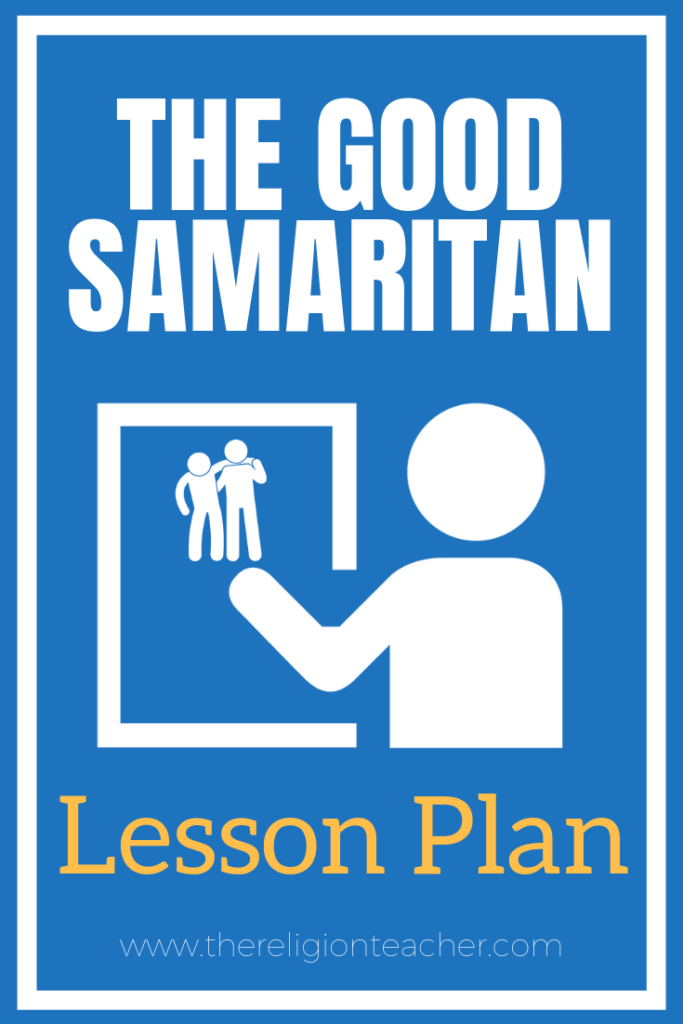
In this lesson, your students will gain a greater appreciation for the ways in which they can love their neighbors as themselves just as the Samaritan did in Jesus’ Parable of the Good Samaritan.
The structure of this lesson is based on the Lectio Divina Lesson Planning model described in the book, Christ in the Classroom, and The Religion Teacher’s Guide to Lesson Planning.
Good Samaritan Lesson Objectives
- Students will be able to summarize the Parable of the Good Samaritan.
- Students will be able to identify ways they can be like the Good Samaritan and love their neighbors as themselves.
- Students will feel compassion towards those who need love and mercy in their lives.
Good Samaritan Lesson Activities
I. Opening Prayer
First invite the students to pray silently for their class neighbors (the students sitting next to them).
Then invite them to pray silently for their literal neighbors (the people who live next door to their homes).
Finally, invite them to pray for anyone they know who is hurting either physically or emotionally.
II. Good Samaritan Lesson Hook
Begin with a lesson hook that gets right to this lesson’s story. Read about the Greatest Commandment and the Parable of the Good Samaritan (Luke 10:25-37) as a class.
You may want to help your students remember the events and people in the story using a video of the parable. For example:
III. Presentation
The students may need a little more background on the people Jesus refers to in the parable. Knowing this background will help them apply the parable more easily to their personal lives.
Use this key to create your own mini-lecture about the parable or show the video explanation below:
Priest: The Jewish priests’ primary responsibility was to make offerings for the people at the Temple to purify them and gain forgiveness for their sins.
Levite: The Levites were the priestly tribe of Israel. They also worked in the Temple on behalf of the Jewish people.
It is likely that the priest and the Levite did not go near the victim’s body because he looked dead and touching a dead body required a ritual washing.
Samaritan: The Samaritans were descendants of the Northern tribes of Israel. Rather than going into exile with the rest of Israel, however, the Samaritan’s ancestors stayed in Israel and intermarried with Gentiles (non-Jews) some of whom worshiped other gods. Therefore, the Jews did not think of them as either Gentiles or Jews and they generally disliked the Samaritans.
Jesus uses this story to explain the unlimited nature of love. Our neighbor is not just someone within our community. Our neighbor is anyone in need of love and mercy. Instead of asking who deserves our love as a neighbor, this parable teaches us that to love beyond the confines of our community or or religion and treat everyone as we ourselves would like to be treated.
IV. Parable of the Good Samaritan Skit
Invite your students to act out the Parable of the Good Samaritan.
You can have them design their own skits based on the reading of the parable or have them use this skit script:
Get the Good Samaritan Skit Script here >
V. Good Samaritan Discussion & Reflection Questions
Help your students make connections between the people in this parable and their own experiences in life. Use these Good Samaritan reflection questions as a guide:
- When have you been like the victim in the story? Who was your Good Samaritan?
- When have you been like the priest or the Levite in the story? Why was it hard to help someone in need?
- When have you been like the good Samaritan in the story? What made you want to help someone in need?
VI. The Parable of the Good Samaritan Worksheet
Download and print this worksheet for your students to use to meditate and pray about this parable. Students will think of times in which they were like the victim, the priest, and the Samaritan in the story. Then they will recall those who have been good Samaritans to them.
To get more worksheets like this one, check out The Religion Teacher’s Parable Worksheet Pack.
VII. The Parable of the Good Samaritan Bandaid Craft
I’ve seen a few bandaid craft ideas to help children learn about the Good Samaritan parable:
- Good Samaritan Bandaid Craft (Crafting Thru the Bible)
- Good Samaritan Armband (Crafting Thru the Bible)
- Good Samaritan Bible Craft (Danielle’s Place)
- Bandaid Relay & Bandaid People (Sermons 4 Kids)
- Compassion Rolls Craft (Our Everyday Life)
This activity could be a great way for younger children to think about loving their neighbors just as the Good Samaritan showed mercy to the victim.
Here is my take on this craft idea:
Have the students think about the situations in which people need help. This could be friends and family who are in pain or more generalized groups of people like the sick, the poor, the elderly, etc.
Then have them write these situations down on index cards. Using actual bandaids or the bandaids in this handout, have them cover up the pain with a bandaid. You might even write the works of mercy on the bandaids before using them to cover up the pain on the index cards.
Or have them ask what they could do to help each person in need? Write these ways to help on the bandaid and cover up the pain.
VIII. The Good Samaritan Parable Prayer Intentions
At the beginning of the lesson, the students prayed silently for their neighbors. Now that they have a greater understanding about who their neighbor is and how to love their neighbor like the Good Samaritan, they will bring the lives of the victims they know to a class prayer time.
Invite the students to think of one person who needs mercy in their lives and share their needs with the class.
After each student offers up the person they would like to pray for, have the class pray, “Lord, hear our prayer” or “Lord, in your mercy, hear our prayer.”
IX. Proof: Good Samaritan Assessment
As an Exit Card assessment, have the students make a list of the things that the Good Samaritan did in the parable. Then on the back of that index card, have them list the ways they can love their neighbor in ways similar to the Good Samaritan.


